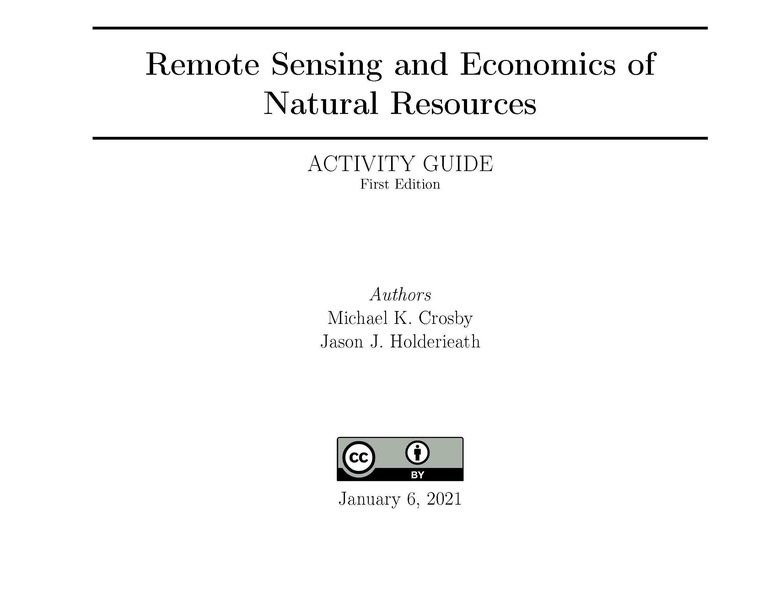- Author:
- Michael Crosby, Jason Holderieath
- Subject:
- Forestry and Agriculture
- Material Type:
- Student Guide
- Level:
- Community College / Lower Division, College / Upper Division
- Tags:
- License:
- Creative Commons Attribution
- Language:
- English
Remote Sensing and Economics of Natural Resources: Activity Guide

Overview
An activity guide designed to take a student through a two course series of remote sensing and natural resource economics leading to a final project.
Preface and Text
Accurate and timely information is required to make sound, informed decisions. In the 21\textsuperscript{st} century, the ability to access and analyze data and use the results to make economically impactful decisions is vital to the success of any industry or enterprise. Spatial technologies offer a streamlined, impactful suite of tools and methods of analysis that can be utilized to make ecological and economic decisions. Natural Resource Economics, then, teaches the approach and process of making economic decisions for the valuation and allocation of natural resources (forests, agriculture, etc.).
Therefore, this text will cohesively combine materials that will be useful in an introductory remote sensing course that would provide a thorough background in the application and analysis of remotely-sensed data and syncing it with natural resources economics. This text contains applied exercises, with requisite background information, relevant to their respective courses -- i.e., Remote Sensing of Natural Resources and Natural Resources Economics. This will provide students in natural resources fields a continuous learning opportunity to understand ``how'' and ``why'' data is obtained and utilized in making application-based decisions.
Remote Sensing
The following guides and tutorial videos are meant to provide instruction for an introductory level remote sensing course. The examples, guides, and videos all use openly/freely available data from government databases and typically uses Google Earth Engine for analysis -- there is one exercise using GIMP2 and one that uses FUSION (both
freely available). The guides step through developing scripts in Earth Engine and provide the code, in whole, at the end of each guide. The guides do not include geometry or datasets so users are cautioned to review the guides to create these -- if users name the variables for imagery, geometry, etc., the same as the guides, the code will work. Most of the analysis focuses on Louisiana, Lincoln Parish, Ruston, LA, and the campus of Louisiana Tech University; notable exceptions are the introductory exercise (Iceland) and the LiDAR exercise where a dataset from the U.S. Forest Service is used (Washington State). However, the guides are easily adaptable to anywhere and other instructors or professionals are free to create their own examples. These guides were, generally, developed using Earth Engine Resources for Higher Education that can be accessed at https://developers.google.com/earth-engine/tutorials/edu. Those interested in introductory or advanced analysis can (should) refer to these resources.
While no textbook was officially used in this course, resources were made available to students. Some excellent places to look are https://www.nrcan.gc.ca/maps-tools-publications/satellite-imagery-air-photos/tutorial-fundamentals-remote-sensing/9309 (Canada Centre for Mapping and Earth Observation; this is a textbook) and https://landsat.gsfc.nasa.gov/ (a series of resources for the Landsat program). In the course at Louisiana Tech, students are referred to these resources to aid with practical examinations, given approximately every third week and include a dataset and a series of questions or a problem to solve. This time might just as well be allocated to exercise completion if other instructors see the need for such a change.
The idea behind creating these resources was to have an open-access option for students (or others) to use, particularly those that may be interested in adding Google Earth Engine to the toolkit. There may be other resources available that I am not aware of and certainly there are likely easier ways to code/script to perform analysis. If and as my skill grows, I will update guides with any changes. The guides are accompanied by a series of short-duration videos and topics are presented by more traditional lectures (PDF slides are available); the
videos are captioned. If there are mistakes in the guides or with video captions -- technical or otherwise -- please contact me via email (mcrosby@latech.edu) and I will work to correct them. Hopefully, these resources prove useful to you and/or your students.
Natural Resource Economics
Remote sensing is an important tool in natural resource economics. Students who have taken Remote Sensing will be able to utilize this experience for a richer final project (and should take the honors version if they are eligible). However, students who have not taken Remote Sensing will not be at a disadvantage.
The natural resource text will cover the basics of the discipline and with an exercise after each chapter. Some chapters call for the instructor to write the exercise, others are writing prompts that are included in the text. The writing assignments give the student free reign to explore a passion project, with some guidance. At the end of the course will be a final project using remotely sensed data and a valuation of a resource base change.